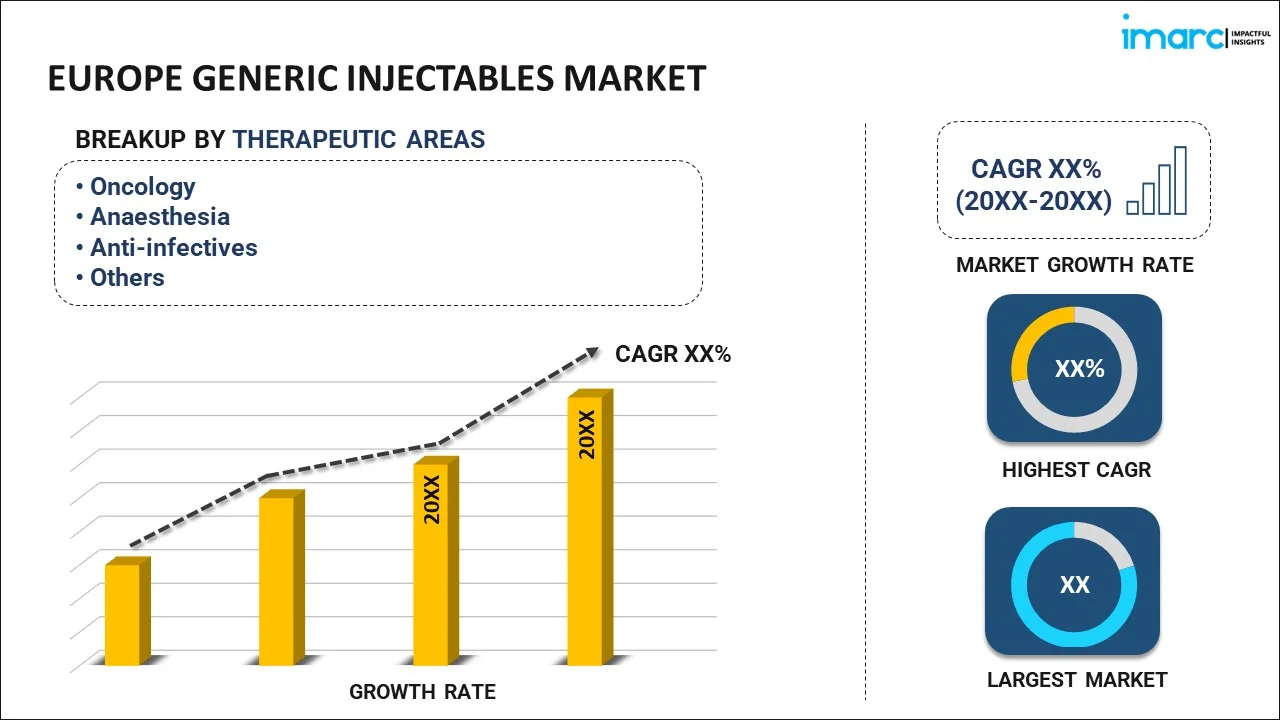
Europe Generic Injectables Market Report by Therapeutic Area (Oncology, Anaesthesia, Anti-infectives, Parenteral Nutrition, Cardiovascular), Container (Vials, Ampoules, Premix, Prefilled Syringes), Distribution Channel (Hospitals, Retail Pharmacy), and Country 2025-2033
Market Overview:
The Europe generic injectables market size reached USD 22.6 Billion in 2024. Looking forward, IMARC Group expects the market to reach USD 43.0 Billion by 2033, exhibiting a growth rate (CAGR) of 7.46% during 2025-2033.
|
Report Attribute
|
Key Statistics
|
|---|---|
|
Base Year
|
2024 |
|
Forecast Years
|
2025-2033
|
|
Historical Years
|
2019-2024
|
| Market Size in 2024 | USD 22.6 Billion |
| Market Forecast in 2033 | USD 43.0 Billion |
| Market Growth Rate (2025-2033) | 7.46% |
Generic injectables refer to alternative drugs that are equivalent to their branded counterparts in terms of the dosage, quality, strength, performance, and intended use. Generic injectables are beneficial in treating various life-threatening and chronic diseases, such as cancer, diabetes, rheumatoid arthritis, cardiovascular ailments, and respiratory infections. They aim to maximize patient compliance and reduce the frequency of administered dosage, thereby maintaining the effectiveness of the treatment.
The increasing prevalence of chronic diseases across Europe represents the key factor driving the market growth. In line with this, intravenous (IV) and intramuscular (IM) routes of drug administration are gaining widespread preference in the healthcare sector for fast drug delivery and for treating patients that are incapable of taking oral doses of medication. This is contributing to the market growth in the region significantly. Additionally, generic injectables are cost-effective as compared to branded drugs, which is acting as another growth-inducing factor. Apart from this, the increasing shortage of medicines and expiry of patents of branded items, are further creating a positive outlook for the market in Europe.
Key Market Segmentation:
IMARC Group provides an analysis of the key trends in each segment of the Europe generic injectables market report, along with forecasts at the regional and country levels from 2025-2033. Our report has categorized the market based on therapeutic area, container, and distribution channel.
Breakup by Therapeutic Area:

- Oncology
- Anaesthesia
- Anti-infectives
- Parenteral Nutrition
- Cardiovascular
Breakup by Container:
- Vials
- Ampoules
- Premix
- Prefilled Syringes
Breakup by Distribution Channel:
- Hospitals
- Retail Pharmacy
Breakup by Country:
- Germany
- France
- United Kingdom
- Italy
- Spain
- Others
Competitive Landscape:
The competitive landscape of the industry has also been examined along with the profiles of the key players.
Report Coverage:
| Report Features | Details |
|---|---|
| Base Year of the Analysis | 2024 |
| Historical Period | 2019-2024 |
| Forecast Period | 2025-2033 |
| Units | Billion USD |
| Segment Coverage | Therapeutic Area, Container, Distribution Channel, Country |
| Countries Covered | Germany, France, United Kingdom, Italy, Spain, Others |
| Customization Scope | 10% Free Customization |
| Post-Sale Analyst Support | 10-12 Weeks |
| Delivery Format | PDF and Excel through Email (We can also provide the editable version of the report in PPT/Word format on special request) |
Key Questions Answered in This Report
The Europe generic injectables market was valued at USD 22.6 Billion in 2024.
We expect the Europe generic injectables market to exhibit a CAGR of 7.46% during 2025-2033.
The rising prevalence of various chronic diseases, such as cancer, diabetes, osteoporosis, rheumatoid arthritis, etc., along with the increasing adoption of generic injectables, as they are cost-effective and offer enhanced patient outcomes, is primarily driving the Europe generic injectables market.
The sudden outbreak of the COVID-19 pandemic has led to the growing demand for generic injectables across several European nations, owing to the introduction of self-injection devices to reduce the risk of the coronavirus infection upon hospital visits or interaction with healthcare professionals.
Based on the therapeutic area, the Europe generic injectables market can be divided into oncology, anesthesia, anti-infectives, parenteral nutrition, and cardiovascular. Among these, oncology currently holds the majority of the total market share.
Based on the container, the Europe generic injectables market has been segmented into vials, ampoules, premix, and prefilled syringes, where vials exhibit a clear dominance in the market.
Based on the distribution channel, the Europe generic injectables market can be segregated into hospitals and retail pharmacy. Currently, hospitals account for the largest market share.
On a regional level, the market has been classified into Germany, France, United Kingdom, Italy, Spain, and others, where Germany currently dominates the Europe generic injectables market.
Need more help?
- Speak to our experienced analysts for insights on the current market scenarios.
- Include additional segments and countries to customize the report as per your requirement.
- Gain an unparalleled competitive advantage in your domain by understanding how to utilize the report and positively impacting your operations and revenue.
- For further assistance, please connect with our analysts.
 Inquire Before Buying
Inquire Before Buying
 Speak to an Analyst
Speak to an Analyst
 Request Brochure
Request Brochure
 Request Customization
Request Customization




.webp)




.webp)












